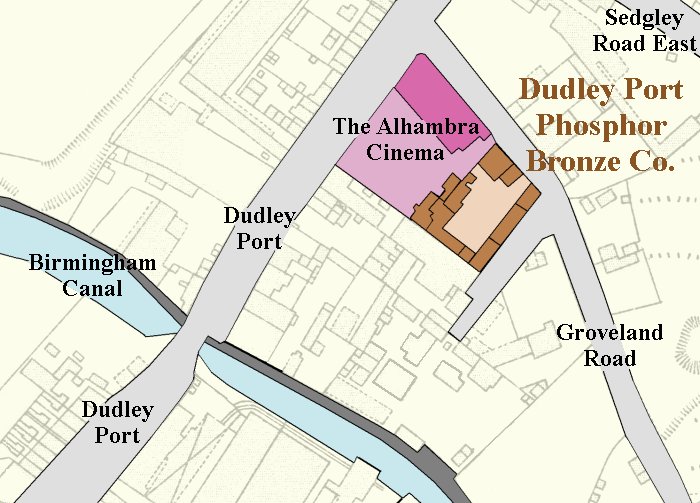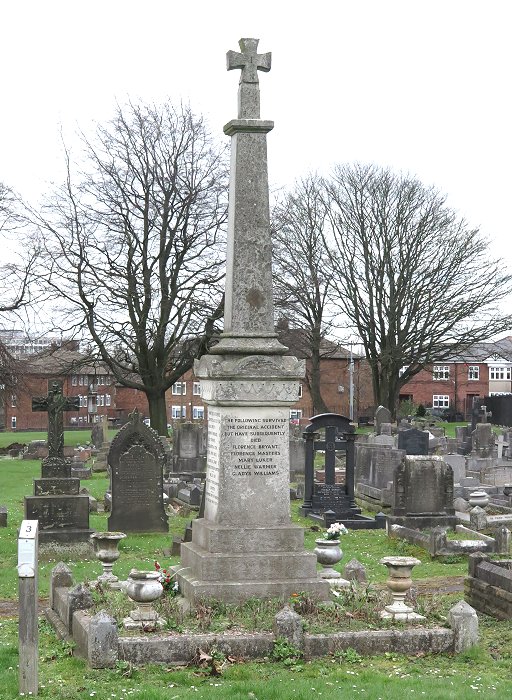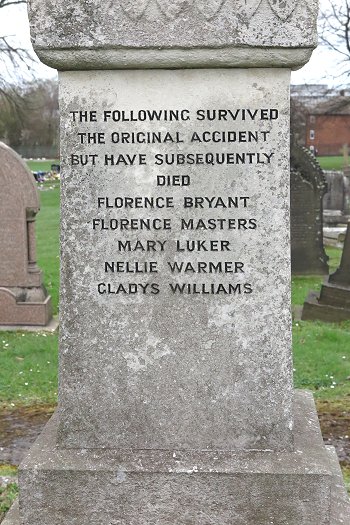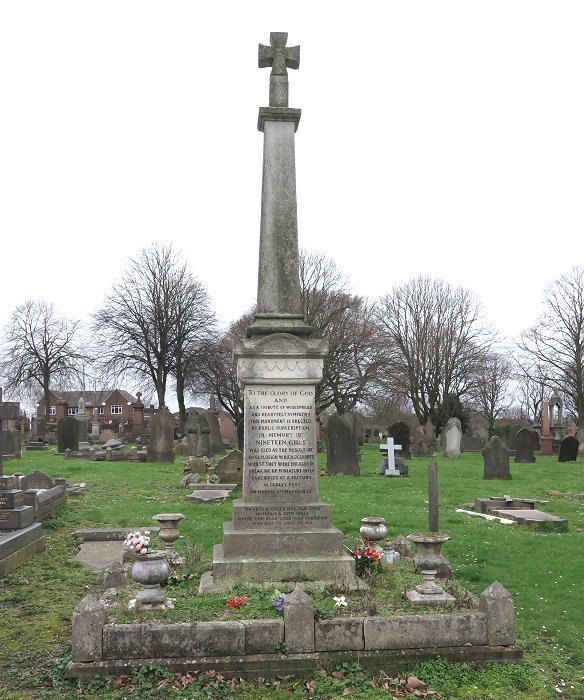|
 |
|
A Tragic
Accident
During the First World War,
vast amounts of munitions were manufactured as part
of the war effort. When the war ended, there was a
large amount of unused ammunition to be disposed of,
some of which was recycled for scrap metal. From the
end of 1918 to 1920 there was a spell of prosperity,
followed by a deep recession, and much unemployment,
which lasted for a number of years.
Some firms cheaply purchased
ex-military ammunition for recycling, as a way to
earn money at this difficult time. Breaking-up live
ammunition to recover lead and copper, is, and was a
dangerous business. An appropriate explosives
license had to be obtained, high levels of staff
training were required, suitable workshop facilities
and protective clothing were essential, and health
and safety rules had to be followed.
It is listed in a Government
report that Major Philip Sydney Babty bought 45 to
47 million rounds of miniature live ammunition from
the Disposal Board and sold it to Premium Aluminium
Casting Company Limited of Birmingham. The company
always obeyed the health and safety rules, had
proper facilities, and paid between £3 and £4 a week
to the young girls who carried out the dangerous
work. In 1922, the company sold
160 tons of live 0.22 cartridges to the Dudley Port
Phosphor Bronze Company, who had a foundry in Groveland
Road, Dudley Port. The business was owned by Louisa Kate
Knowles and run by her husband John Walter Knowles, who
asked Harry Andrews, one of Premium Aluminium’s
Directors if he could get some ammunition for him, in
order to recover the lead and copper. He agreed to pay
£500 for the ammunition, plus half the profits from the
sale of the scrap metal. |
|

The location of the Dudley Port
Phosphor Bronze Company. |
|
It seems that another of Premium
Aluminium’s Directors, Mr. R. V. Dawkins carefully
advised Knowles, before delivery, about the health and
safety issues and informed him that he needed the
appropriate explosives licence. Knowles assured him that
he had one and ignored all of his advice. The workshop
in Groveland Road was totally unsuitable for the work in
hand. All that mattered was short-term profit.
Mr. and Mrs. Knowles ran a small
foundry on the Groveland Road site. They decided to use
an old pattern shop for recycling the cartridges, which
was 30 feet long by 27 feet wide, with a concrete floor,
and an old stove in the middle that had been used for
heating iron bars. There were no extractor fans or
proper ventilation. In order to maximise their profit,
they employed young girls between the ages of 13 and 16,
on very low wages, with no safety training, and no
protective clothing. They were paid between 2 shillings
and 4 pence and 3 shillings and 4 pence per week. 30
girls were involved in the project, but the actual
number at work on any day varied.
Ebor Chadwick, the foundry foreman,
was instructed to oversee the operation, even though he
had no experience with explosives and no safety
training. He realised that it was dangerous to use the
stove in the workshop because of the danger of an
explosion from the gunpowder dust that covered the
concrete floor and many flat areas, but his worries were
ignored by Knowles, who told him 'not to be silly'.
Chadwick usually left the girls to their own devices. He
hardly ever entered the workshop.
Monday the 6th March, 1922, began like any
other day in the workshop. It was a cold morning and so
a good fire was burning in the stove and the girls
happily worked, sitting on the ammunition boxes while
separating the lead and the copper in the 0.22 caliber
cartridges and tipping the gunpowder into open boxes,
that would be emptied into the canal at the end of the
day. At about a quarter to twelve, something terrible
happened. A spark, either from the stove, or possibly from one of
the girls’ hobnail boots on the concrete floor, caused a
massive explosion that blew the roof off the building.
The explosion sounded like a clap of thunder, as a thick
cloud of black smoke rose above the badly damaged
building and the pungent smell of gunpowder filled the
air.
After a short silence, the screams
and cries of the injured girls could be heard, as people
rushed to the factory to help. They came across a
terrible scene of death, injury and destruction. The
survivors were left with horrible burns and injuries. Some were naked
because their clothes had been blown away. They were
carefully covered with bags and sacks and conveyed to nearby Dudley Guest Hospital for treatment.
Within twelve hours of the explosion, twelve of the
girls were dead.
|
|

The memorial to the girls in
Tipton Cemetery. |
|
The hospital staff did all that
they could to save the others, but in spite of their
efforts another four died within hours, and three others
died in the following weeks. Four of the badly burned
girls survived against all the odds, thanks to the new
treatment of skin grafting, but their terrible injuries
would greatly affect the rest of their lives.
There was a huge public outcry over the way the girls
had been terribly exploited and treated by Mr. and Mrs.
Knowles. One man even walked to Dudley from Sheffield, to
offer some of his skin to save one of the girls.
Questions were asked in Parliament and Mr. and Mrs.
Knowles and Ebor Chadwick were charged with ‘feloniously
killing and slaying Mabel Weaver’. Mrs Knowles, as owner
of the factory, was also charged with storing explosives
without a licence.
The trial was soon held at Stafford
Assizes. Wealthy John Knowles, engaged the services of
one of the best lawyers, Sir Henry Curtis Bennett, and
they all pleaded not guilty. |
 |
 |
|
The
inscriptions on the four sides of the memorial. |
|
The Judge, when summing up, stated
that it was the worst case of manslaughter, he had ever
come across. He found it difficult to believe that
Knowles, a man with intelligence, could claim he knew
nothing whatever about the explosive act, after being
given advice, and some guidance from the Premium
Aluminium Casting Company Limited. Like many others he
said, Knowles had chosen, in the pursuit of avaricious
greed, to exploit, and put in extreme danger, very young
girls, desperate for work.
The court also found that it was
the duty of Mr. H. Andrews and Mr. R. V. Dawkins,
directors of Premium Aluminium Castings to see that the
ammunition was broken down under proper precautions, and
that their negligence was a contributing cause of the
explosion.
The jury decided that Louisa Kate
Knowles and Ebor Chadwick were not guilty, and so they
were acquitted. John Walter Knowles, aged 55, was
sentenced to five years Penal Servitude. Knowles lodged
an appeal against the sentence, but this was refused.
Many people at the time thought that his sentence was
far too short and that he had got off lightly.
Louisa Knowles, as the factory
owner, was ordered to pay compensation of £10,000 to the
families of the dead and injured. Only £5,650 of this
was recorded as being received. Both her and her husband
were wealthy and lived in a grand house. When John
Knowles died in 1951 he left over £50,000 in his will
and when his wife died in 1955 she left an estate valued
at £93,000. After the trial, Louisa Knowles
sold the Groveland Road factory, to Thomas Dudley.
The exact number of survivors of
the accident is uncertain. It is often stated that there
were four, but some records state that there were six.
Compensation was paid as follows: Mrs Bryant, who was
seriously, injured received £1,230. Three of the others,
who were seriously injured, each received £900. Another
girl, badly injured, received £200 and an injured child
received £105. The dependents of the 19 dead girls each
received £75. As already stated, the remainder of the
compensation was never paid.
| From a
contemporary newspaper cutting
from an unknown newspaper:
At Stafford Assizes, John Walter
Knowles, 55, manufacturer, was
found guilty of the manslaughter
of Mabel Weaver, one of the
victims of the Tipton workshop
on March 6. Mr. Justice Shearman
sentenced him to five years
penal servitude. Eber James
Richard Chadwick, 31, works
manager to Knowles, was found
not guilty and was discharged.
The girls
were engaged in breaking down
miniature rifle ammunition when
the explosion occurred. After
the verdict, Mr. Justice
Shearman was informed that
nineteen had died from their
injuries, and three were still
in hospital. The police proved a
previous conviction against
Knowles of eighteen months
imprisonment for receiving
stolen metal, and several
convictions for contraventions
of the Factory Act.
Mr. Graham
Milward, who defended Knowles,
said that ammunition worth
£2,800 had been seized by the
authorities, and there were
twenty three actions pending as
a result of the explosion.
In passing
sentence Mr. Justice Shearman
this was one of the worst cases
of manslaughter he had ever had
to deal with. He was not taking
into consideration any previous
offences at all. Knowles saw an
opportunity, as so many people
did now, to make a big profit on
a transaction. There was gross
exploitation of the labour of
little girls and boys – the
sweepers were the little boys –
in order to get more profit out
of it. If he were to treat the
case lightly he should be
wanting in his duty. |
|
A public appeal raised £4,766. Three of the girls,
all disfigured and disabled, were trained at college as
commercial clerks. They each received 12 shillings per
week, and a £6 dress allowance. The invested funds
provided the disabled girls, 5 in total, with a lifetime
income of 17 shillings a week, or a lump sum of £133 on reaching
the age of 21. The bereaved parents also
received funds from the Dudley Port Explosion Fund, which
raised over £10,000.
Councillor and hinge manufacturer, William Wooley
Doughty, J.P., Chairman of Tipton Urban District
Council, set up a relief fund on behalf of the town to pay for funerals etc.
|
The 19 girls who
sadly lost their lives, were as
follows:
| Elizabeth Aston |
age
14 |
|
Died
later, no address given. |
| Gladys
May Bryant |
age
14 |
|
15 West
Street, Dudley Port. |
| Margaret
(Maggie) Burns |
age
15 |
|
Sheepwash
Lane, West Bromwich. |
| Laura Dalloway |
age
15 |
|
36 Upper Church
Street, Tividale. |
| Edith Drew |
age
15 |
|
No1 House, 1
Court, Boat Row,
Tipton. |
| Annie
Eliza Florence Edwards |
age
15 |
|
77 "A" Block,
Munitions Huts,
Dudley. |
| Lucy Edwards |
age
14 |
|
Died some weeks
later. 3 Sheepwash Street, Tipton. |
| Elsie Follows |
age
15 |
|
196 Dudley Port. |
|
Violet May Franklin |
age
15 |
|
17 Cleton Street, Tipton. |
| Annie Freeth |
age
15 |
|
42 Farley
Street, Great
Bridge. |
|
Lily Griffiths |
age
15 |
|
Railway Street, Horseley Heath. |
|
Hannah Hubbard |
age
16 |
|
No.1 House, 5
Court, Dudley Port. |
|
Ethel May Jukes |
age
15 |
|
Died some time
later, no address
given. |
|
Nellie Kay |
age
15 |
|
Dudley Port,
Tipton. |
| Priscilla Longmore |
age
13 |
|
337 Dudley Port. |
|
Annie Naylor |
age
14 |
|
162 Dudley Port. |
|
Edith Richards |
age
14 |
|
Factory Road,
Tipton. |
|
Mabel Weaver |
age
14 |
|
3 Victoria
Terrace, Tipton. |
|
Elizabeth (Lizzie) Williams |
age
13 |
|
Cross Street,
Tipton. |
The five
survivors listed on the
memorial were:
Florence Bryant,
Florence Masters,
Mary Luker, Nellie
Warmer and Gladys
Williams
|
|
|

A final view of the memorial.
 |
Return to
the
previous page |
|